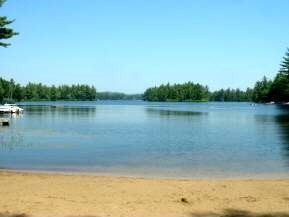Lake type Natural w/ dam Primary outflows Mill Brook Max. length 4.0 mi (6.4 km) Surface elevation 133 m Length 6.4 km | Primary inflows Basin countries United States Area 5.257 km² Mean depth 6.2 m | |
 | ||
Similar Echo Lake, Silver Lake, Ossipee Lake, Dan Hole Pond, Pine River Pond | ||
Conway Lake is a 1,316-acre (5 km2) water body with a maximum depth of 45 feet (14 m), located in Carroll County in eastern New Hampshire, in the United States. The lake is located in the towns of Conway and Eaton, just to the east of the White Mountains, and is part of the Saco River watershed.
Contents
- Map of Conway Lake New Hampshire 03813 USA
- HistoryEdit
- Fish speciesEdit
- UsesEdit
- The legend of Ol Pork Chop ScarEdit
- References
Map of Conway Lake, New Hampshire 03813, USA
HistoryEdit
Conway Lake was formerly known as Walker's Pond. At the northern edge of the lake on Mill Street there is a park by that name that comprises the Conway Lake Dam and original mill site. In 1773, 100 acres (40 ha) were granted to Captain Timothy Walker by the town of Conway, in order to build a sawmill and gristmill. It was later sold to H. B. Cotton, who began to make boxes and piano backings. Henry Peary was the last owner of the mill, but it burned down and was never rebuilt, hurting the town's economy. In 1817 the Gazetteer of the State of New Hampshire said of Conway: "It contains 4 corn mills, 5 saw mills, 1 mill for dressing cloth, 2 carding machines, 3 distilleries, and 3 retail stores."
It was not until the coming of the train tracks in 1865 that the mills started to prosper. At that time logs were floated over Conway Lake for processing before being hauled off by freight car to Portsmouth and other places. Together with the nearby granite from Redstone, the mills on Mill Street were responsible for producing wood for several train stations in New England.
A public beach was added in 1952, deeded to the town from Public Service Company of New Hampshire. The town raised $100 for improvements to the beach. With the success of the public beach the town soon added a boat launch.
Sokoki Indian relics have been found on the lake. George Chapman found artifacts around 1965. They were found in the Sokoki village on the north shore of the lake.
Fish speciesEdit
Species in Conway Lake include the following warm-water freshwater fish: chain pickerel, hornpout (same as BBH – brown bullhead), landlocked salmon, largemouth bass, rainbow trout, and smallmouth bass. The New Hampshire Fish and Game Department manages the lake for landlocked salmon; fishing licenses are required, and the lake waters are patrolled regularly.
UsesEdit
Through the years, Conway Lake has been a source for recreation. There is one public beach located off Mill Street in Conway. The lake has one public campground, Cove Camping Area, which is located in the Eaton portion of the lake. The lake is utilized for swimming, boating, canoeing, and fishing.
The legend of Ol' Pork Chop ("Scar")Edit
The lake is home to herons, loons, eagles, deer, snakes, stinkpot turtles, painted turtles and snapping turtles. According to older residents, there exists a very old and very large snapping turtle named Pork Chop, who is so-called because a summer resident claims to have fed the turtle pork chops each year. Stories of Ol' Pork Chop have been used successfully to coax children out of the water, but there have been no known snapping turtle attacks reported (aside from those on unsuspecting ducklings). Residents of the inlet on the north end of the lake call this turtle "Scar" due to a prominent laceration across his face. Aside from pork chops, Scar appears to favor leftover pizza crusts in supplement to his typical lake fare.
